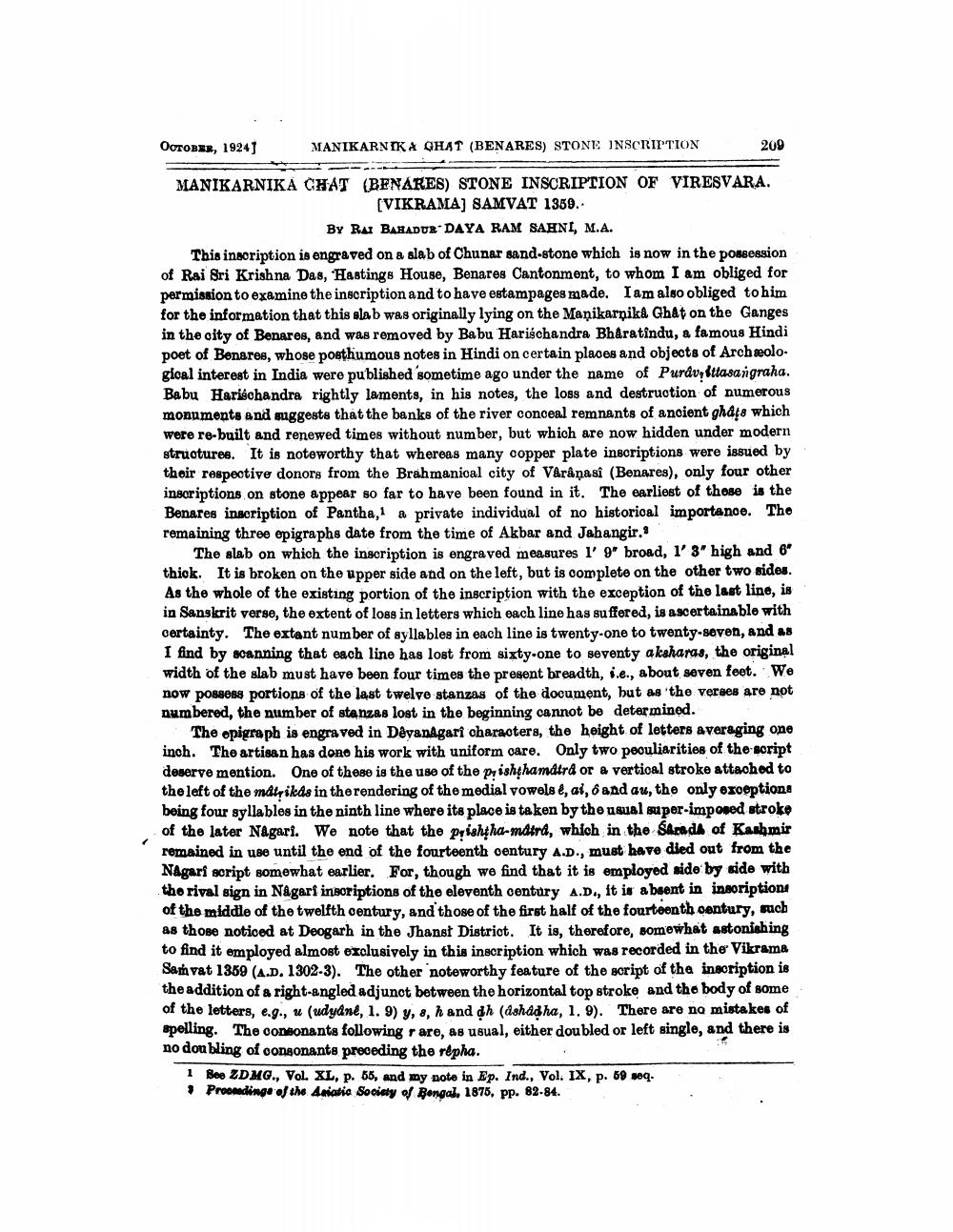________________
OCTOBER, 1924]
MANIKARNIKA GHAT (BENARES) STONE INSCRIPTION
MANIKARNIKA CHAT (BENARES) STONE INSCRIPTION OF VIRESVARA.
[VIKRAMA] SAMVAT 1359..
BY RAI BAHADUR DAYA RAM SAHNI, M.A.
209
This inscription is engraved on a slab of Chunar sand-stone which is now in the possession of Rai Sri Krishna Das, Hastings House, Benares Cantonment, to whom I am obliged for permission to examine the inscription and to have estampages made. I am also obliged to him for the information that this slab was originally lying on the Manikarnika Ghat on the Ganges in the city of Benares, and was removed by Babu Harischandra Bharatîndu, a famous Hindi poet of Benares, whose posthumous notes in Hindi on certain places and objects of Archeological interest in India were published sometime ago under the name of Puravlttasangraha. Babu Harischandra rightly laments, in his notes, the loss and destruction of numerous monuments and suggests that the banks of the river conceal remnants of ancient ghats which were re-built and renewed times without number, but which are now hidden under modern structures. It is noteworthy that whereas many copper plate inscriptions were issued by their respective donors from the Brahmanical city of Varanasi (Benares), only four other inscriptions on stone appear so far to have been found in it. The earliest of these is the Benares inscription of Pantha, a private individual of no historical importance. The remaining three epigraphs date from the time of Akbar and Jahangir."
The slab on which the inscription is engraved measures 1' 9" broad, 1' 3" high and 6" thick. It is broken on the upper side and on the left, but is complete on the other two sides. As the whole of the existing portion of the inscription with the exception of the last line, is in Sanskrit verse, the extent of loss in letters which each line has suffered, is ascertainable with certainty. The extant number of syllables in each line is twenty-one to twenty-seven, and as I find by scanning that each line has lost from sixty-one to seventy aksharas, the original width of the slab must have been four times the present breadth, i.e., about seven feet. We now possess portions of the last twelve stanzas of the document, but as the verses are not numbered, the number of stanzas lost in the beginning cannot be determined.
The epigraph is engraved in Devanagari characters, the height of letters averaging one inch. The artisan has done his work with uniform care. Only two peculiarities of the script deserve mention. One of these is the use of the prishthamåtrå or a vertical stroke attached to the left of the matrikds in the rendering of the medial vowels ê, ai, 6 and au, the only exceptions being four syllables in the ninth line where its place is taken by the usual super-imposed stroke of the later Nagari. We note that the prishtha-matra, which in the Sarada of Kashmir remained in use until the end of the fourteenth century A.D., must have died out from the Nagari script somewhat earlier. For, though we find that it is employed side by side with the rival sign in Nagari inscriptions of the eleventh century A.D., it is absent in inscriptions of the middle of the twelfth century, and those of the first half of the fourteenth century, such as those noticed at Deogarh in the Jhansi District. It is, therefore, somewhat astonishing to find it employed almost exclusively in this inscription which was recorded in the Vikrama Samvat 1359 (A.D. 1302-3). The other noteworthy feature of the script of the inscription is the addition of a right-angled adjunct between the horizontal top stroke and the body of some of the letters, e.g., u (udydné, 1. 9) y, 8, h and dh (ásháḍha, 1. 9). There are no mistakes of spelling. The consonants following rare, as usual, either doubled or left single, and there is no doubling of consonants preceding the rêpha.
1 Bee ZDMG., Vol. XL, p. 55, and my note in Ep. Ind., Vol. IX, p. 59 seq. * Proceedings of the Asiatic Society of Bengal, 1875, pp. 82-84.




